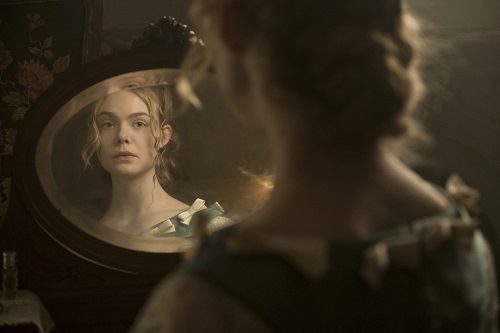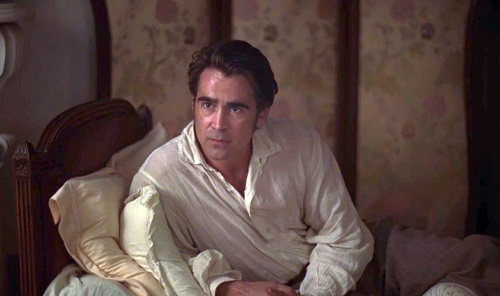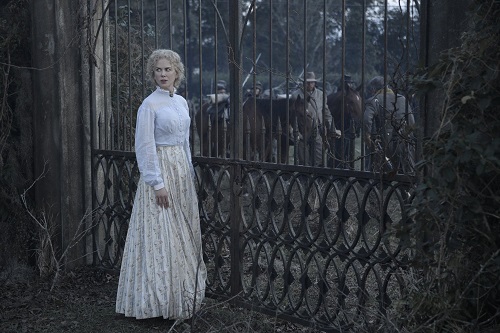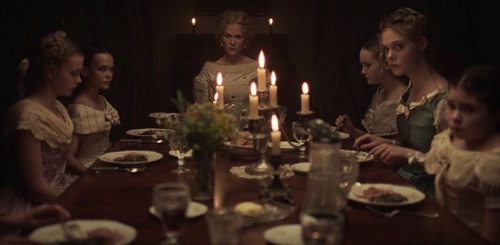Synopsis: At a girls’ school in Virginia during the Civil War, where the young women have been sheltered from the outside world, a wounded Union soldier is taken in. Soon, the house is taken over with sexual tension, rivalries, and an unexpected turn of events.
Release Date: June 30, 2017 MPAA Rating: PG-13
Genre(s): Drama, Western
Film Review

Production
One of the big buzzes coming out of the 2017 Cannes International Film Festival was the fact that Sofia Coppola (Lost in Translation) won the Best Director award for The Beguiled, an award that had only once before been given to a woman (and that was way back in 1961 when Russian filmmaker Yuliya Solntseva took the honor for Chronicle of Flaming Years). Now, The Beguiled is being given a wide release, and audiences can see for themselves what all of the fuss is about.
Set in 1864, three years into the Civil War, in the war-torn Confederate South, The Beguiled begins with a young girl named Amelia (Oona Laurence from Pete’s Dragon) coming across a wounded Union soldier named Corporal John McBurney (Colin Farrell from The Lobster and Fright Night) while gathering mushrooms near her girls’ boarding school. She brings him back to the school, where the headmistress, Miss Martha Farnsworth (Nicole Kidman from and Stoker), agrees to nurse him back to health before turning him over to the Confederate troops as a prisoner. Once Corporal McBurney gains his strength, he realizes that his best chance to stay out of enemy hands is to charm the young ladies at the school, particularly teacher Miss Edwina (Kirsten Dunst from Hidden Figures) and older student Alicia (The Neon Demon‘s Elle Fanning), into continuing to harbor him. All of the deceit inside the house becomes more destructive than the cannonballs outside of it.

Sofia Coppola’s The Beguiled marks the second time that Thomas Cullinan’s novel of the same name has been made into a movie – the first was a 1971 Clint Eastwood vehicle directed by Don Siegel of Invasion of the Body Snatchers and Escape from Alcatraz fame. Coppola’s screenplay sticks fairly close to the story of the 1971 version (original writers Albert Maltz and Irene Kamp even share “based on” credit), but it differs in the perspective of the narrative. Predictably, Coppola’s film has more of a feminine gaze to it, without as much tough-guy machismo and superiority to fuel the fire, which has just as much to do with Colin Farrell’s properly-polite performance as it does with Sofia Coppola’s confident direction.
Of course, Coppola most likely directed Farrell to give that type of a performance, so there’s that angle, too. The point is, The Beguiled is a softer, gentler film than its predecessor. Or, at least the first hour is. Then it turns a corner and gets dark. Really dark. The third act is almost like watching a different movie, the event that ushers it in signaling a change in tone and the film going from the subtle mystery of Picnic at Hanging Rock to the cackling lunacy of a “Tales from the Crypt” episode in seconds flat.

At the center of The Beguiled is a question of loyalty and betrayal, and whether or not McBurney can come between the girls in the school. He essentially tells each one what they want to hear (he even tells little Amelia that she’s his “best friend here”), with varying degrees of success. Some girls are fooled, some are flattered, and some are just annoyed. But in each case, there are flaws in McBurney’s manipulations, more obvious to the audience than to the characters, which will hinder his plan to drive wedges between the girls.
There is one notable excision that Coppola’s The Beguiled makes from the original, and that is the presence of a slave woman named Hattie. There are no slaves in Coppola’s film – at one point, Martha mentions how the slaves have all left, but there are none that appear in the film, despite it being set in Virginia in the middle of the Civil War. On the one hand, it takes the focus from the film away from race and puts it squarely onto gender. One the other, though, it’s much less believable.

The Beguiled seems to transcend genre. Is it a western? Not really. A war movie? It’s set during a war and one of the main characters is a soldier, but it can’t really be called that, either. Southern gothic? That’s probably as close as anything, with the macabre last half hour skirting just on the shallow side of horror. It’s a period movie, but doesn’t feel like one, despite the stuffy language and tight-laced costumes. It’s a tough film to pin down, but fortunately, it’s not tough to watch and enjoy. It’s very good.

Cinematography
The Beguiled is beautifully shot by cinematographer Philippe Le Sourd (The Grandmaster). Le Sourd embraces the nineteenth century time period of the film, going to great lengths to make sure all of the sources of light are organic and motivated, whether it’s the flickering from a candle or the sun streaming in through a window. There’s an ever-present mist that hangs around outside the school, never letting the viewer know whether it’s smoke from battle or just fog from the early mornings, and it’s a great effect to symbolize the isolation and confinement of the women and their “prisoner.” Le Sourd changes his style of photography a bit over the course of the film, starting off with soft focus and warm colors to signify the safe space that McBurney has found, then gradually making images darker and more threatening as things in the house get more tense and volatile. It’s a subtle change, a genius technique from a genius cinematographer. And it looks great.

Cast and Crew
- Director(s): Sofia Coppola
- Producer(s): Roman CoppolaSofia CoppolaYouree Henley
- Screenwriter(s): Sofia Coppola
- Story: Thomas Cullinan
- Cast: Colin Farrell (John McBurney)Nicole Kidman (Martha Farnsworth)Kirsten Dunst (Edwina Dabney) Elle Fanning (Alicia)Oona Laurence (Amy)Angourie Rice (Jane)Addison Riecke (Marie)Emma Howard (Emily)
- Editor(s): Sarah Flack
- Cinematographer: Philippe Le Sourd
- Production Designer(s):
- Costume Designer: Stacey Battat
- Casting Director(s): Courtney BrightNicole Daniels
- Music Score: Laura Karpman
- Music Performed By: Phoenix
- Country Of Origin: USA
